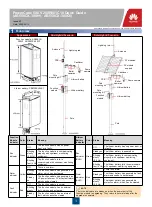
13
15
Power-On Commissioning
14
Verifying the Installation
1. Check the indicators on the function module and lithium batteries. Ensure that the green indicators are blinking slowly and that the
yellow and red indicators are off.
2. If a problem is found, refer to the alarm definitions in the user manual for troubleshooting.
Observing Indicators
15.1
Logging In to the Device for the First Time
15.2
Before logging in to the device for the first time,
prepare the Console communications cable.
2. Start the terminal emulation software on the PC.
If the PC uses the built-in terminal emulation software (such as HyperTerminal that can support Windows 2000 system), you do not need
to prepare the software separately. If the system does not provide terminal emulation software, obtain free HyperTerminal sof tware such
as PuTTY from the Internet. The following uses the PuTTY as an example to describe how to configure the HyperTerminal software.
3. Choose
Session
and set
Connection type
to
Seria
.
Select the connected port based on the actual situation. For example, on supported Windows systems, view the port information in
Device Manager
and select the connected port.
Ensure that communications parameter settings on the terminal emulation software are the same as the default values on the device:
transmission rate 9600 bit/s, 8 data bits, 1 stop bit, no parity check, and no traffic control.
Parameter
Default Value
Transmission rate
9600 bit/s
Traffic control
No
Parity check
No
Stop bit
1
Data bits
8
Default configuration for the Console
port of the device
4. Select
Serial
and configure serial port parameters.
If you modify the serial port communications parameter settings for
the device, you need to modify the communications parameter
settings on the PC accordingly and then set up a connection again.
NOTE
NOTE
1. Connect the DB9 connector of the Console communications cable to the COM port of a PC, and then connect the RJ45 connector to the
Console port of the device.
NOTE
1. Check that the mounting kits are securely installed and all screws are tightened.
2. Check that all cables are reliably connected with correct polarity and there is no short circuit.
3. Check whether any screw holes are not installed with screws. If so, install screws at the holes.
4. Check that all idle cable holes in modules are protected with waterproof caps.
PC
DB9 female
connector
















